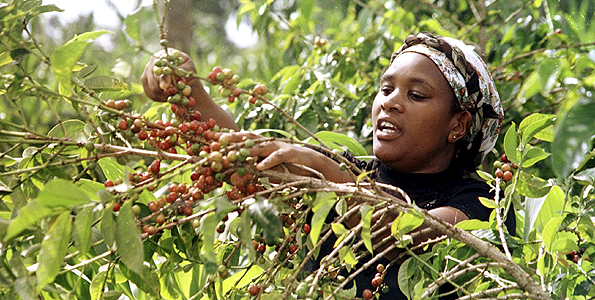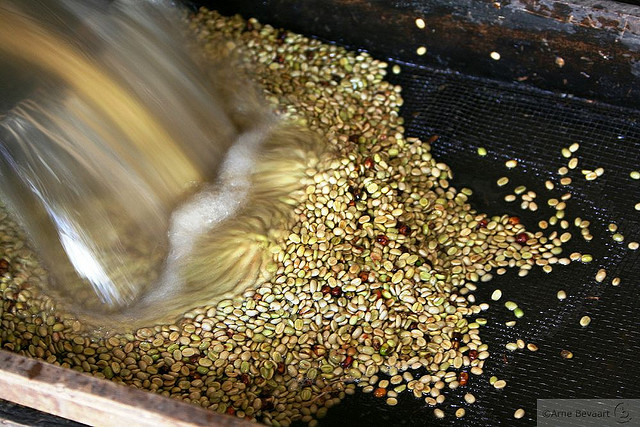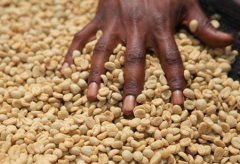Coffee bean hand-picking method Colombian planting Colombian coffee beans Colombian picking
Coffee harvesting
Coffee harvest time and harvest methods vary from place to place, generally speaking, roughly 1-2 times a year, sometimes up to three or four times. Harvest time is mostly in dry season. Brazil, for example, harvests begin around June in Bahia in the northeast and head south in sequence, ending around October in Parana in the south. The harvest period in Central America is from September to January, from lowland to highland.
Harvesting methods can be divided into two categories, one is hand-picking method, the other is shaking method.
Hand picking method:
With the exception of Brazil and Ethiopia, most Arabica coffee-producing countries harvest by hand. Hand picking method is not only mature red coffee beans picked, sometimes together with immature green coffee beans and branches picked together, so these immature beans are often mixed with refined coffee beans, especially when refined by natural drying method. If these beans are baked together, they will produce a disgusting odor.
Shaking method:
This method is to beat the ripe fruit with a random stick or shake the coffee branch, so that the fruit falls into a pile. Large farms use large harvesters, while small and medium-sized farms use the whole family to mobilize people to harvest. This method of shaking the fruit to the ground is more likely to mix impurities and defective beans than the hand-picked method. Some beans from some places will also be stained with strange odors or the beans will ferment because the ground is wet.
Countries producing Robusta beans, such as Brazil and Ethiopia, harvest them in this way.
In countries where the shaking method is used, coffee beans are also refined by natural drying. Coffee blossoms in spring, bears fruit in summer and harvests in winter. Therefore, it is very difficult to harvest and dry in places where the distinction between dry and rainy seasons is not obvious. In rainy season, natural drying method cannot be adopted. Therefore, coffee is suitable for planting in dry and rainy areas.
Colombia's favourable climate provides coffee with a true "natural pasture". Coffee trees in Colombia are mainly cultivated in the Andes mountains, on steep slopes up to 1,300 meters above sea level, where the annual temperature is about 18 degrees Celsius, the annual rainfall is 2000 to 3000 mm, the north latitude is 1 °-11 ° 15, the west longitude is 72 ° -78 °, and the specific altitude range can exceed 2.000 meters. By a particular combination of various factors, latitude, altitude, soil, plant origin of species and variety of coffee making in coffee growing areas of Colombia, climate in coffee growing areas and rain patterns resulting from dual paths of tropical convergence, changing topography throughout the day, luminosity, favorable temperature ranges throughout the year, distribution of moderate and rainwater, and some common cultural practices including selective harvesting and transformation processes, including washing and drying. Very suitable for coffee growth, mild climate, humid air, and can be harvested regardless of season. That's why Colombia coffee is so good. Colombia has three Cordillera mountains running north-south, right into the Andes. Coffee is grown along the highlands of these mountains. The terraces provide a diverse climate, with harvest seasons throughout the year and different types of coffee maturing at different times. And fortunately, unlike Brazil, Colombia doesn't have to worry about frost damage. There are approximately 2.7 billion recorded coffee trees in Colombia, 66 per cent of which are grown on modern plantations and the rest on small traditionally managed farms. [3]
The pure flavor of Colombia coffee comes from the natural environment of Colombia, which has the most favorable conditions for coffee growth. But beyond that, it is inseparable from the hard work of local growers. In Colombia, coffee is cultivated on 1.07 million hectares, there are about 302,000 coffee plantations in the country, and 30 to 40 per cent of the rural population depends directly on coffee production. Although Colombia has many farms, they are not large. Each farm has an area of only about 2 hectares, and more than 80% of coffee plantations have only about 5000 coffee trees, with an average of 3000. Thus, agriculture in Colombia is of the small farm type. Locals plant tall trees or banana trees around coffee trees. During the seedling stage, coffee trees are sheltered to ensure a cool and humid environment for coffee growth. Due to the high humidity in the coffee forest, the small temperature difference, the slow maturity of coffee beans, which is conducive to the accumulation of caffeine and aromatic substances, the coffee quality is the best.
Colombia Santa Rita Special Reserve
Country: Colombia Country
Region: Antioquia
Altitude: 1600-2100 m
Treatment method: washing
Breeds: Kaduai, Kadura
Manor: Santa Rita
Flavor: Sucrose, clean, medium body

Important Notice :
前街咖啡 FrontStreet Coffee has moved to new addredd:
FrontStreet Coffee Address: 315,Donghua East Road,GuangZhou
Tel:020 38364473
- Prev

Colombian coffee bean Arabica seed Dikapunkadullah Mondo Dono Wokadu Amarago
Arabica coffee is generally considered to be originated from the Ethiopian plateau, widely distributed in the tropics, after repeated mutation and breeding, derived a lot of varieties. Tibica: this is the closest Arabica species to the native species. Almost all Arabica varieties are derived from this. It is long in bean shape, has excellent aroma and sour taste, but is not resistant to leaf rust.
- Next

Introduction of boutique coffee bean manor-- Costa Rican coffee goddess coffee manor
Citrus, maple syrup, red cherry, vanilla, a variety of fruits compound sweet and sour. This cup of coffee is called "Goddess". Today, Chongqing Brista Coffee training School will introduce you to a coffee bean produced by the Goddess Manor of Costa Rica in the United States. Goddess beans is a micro-batch Geisha (Rosa / geisha) variety of the Goddess Manor (Dota El Diosa) in Costa Rica, Central America.
Related
- Does Rose Summer choose Blue, Green or Red? Detailed explanation of Rose Summer Coffee plots and Classification in Panamanian Jade Manor
- What is the difference between the origin, producing area, processing plant, cooperative and manor of coffee beans?
- How fine does the espresso powder fit? how to grind the espresso?
- Sca coffee roasting degree color card coffee roasting degree 8 roasting color values what do you mean?
- The practice of lattes: how to make lattes at home
- Introduction to Indonesian Fine Coffee beans-- Java Coffee producing area of Indonesian Arabica Coffee
- How much will the flavor of light and medium roasted rose summer be expressed? What baking level is rose summer suitable for?
- Introduction to the characteristics of washing, sun-drying or wet-planing coffee commonly used in Mantenin, Indonesia
- Price characteristics of Arabica Coffee Bean Starbucks introduction to Manning Coffee Bean Taste producing area Variety Manor
- What is the authentic Yega flavor? What are the flavor characteristics of the really excellent Yejasuffi coffee beans?

